See Page 1 |
2 |
3 |
4 | of the January 2024 homepage
archives. Wednesday the 31st
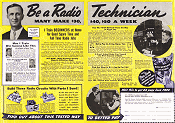 Imagine being able to earn $10 ($183 in
2023 money) or more per week in your spare time as an electronics repairman! That
was the hope given to guys reading the two-page National Radio Institute (NRI) advertising
spread in a 1942 issue of Popular Mechanics magazine. The same ad - or
ones a lot like it - were also commonly seen in other mechanics and electronics
magazines of the day. The Wikipedia entry for National Radio Institute shows a magazine
ad from 1926, and they were still in business through the late 1980s, because yours
truly took NRI's "Electronic Design Technology" home correspondence courses, and
received a certificate in July of 1987. NRI reportedly finally closed its doors
in 2002. The tests at the end of each section were mailed back to NRI for grading... Imagine being able to earn $10 ($183 in
2023 money) or more per week in your spare time as an electronics repairman! That
was the hope given to guys reading the two-page National Radio Institute (NRI) advertising
spread in a 1942 issue of Popular Mechanics magazine. The same ad - or
ones a lot like it - were also commonly seen in other mechanics and electronics
magazines of the day. The Wikipedia entry for National Radio Institute shows a magazine
ad from 1926, and they were still in business through the late 1980s, because yours
truly took NRI's "Electronic Design Technology" home correspondence courses, and
received a certificate in July of 1987. NRI reportedly finally closed its doors
in 2002. The tests at the end of each section were mailed back to NRI for grading...
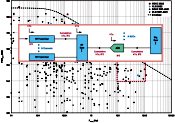 Many papers discuss the system trade-offs
and relative merits of digital vs. RF beamforming, and the hybrid blend thereof.
Building on prior work, this article uses
RF-to-ADC cascade modeling to show dynamic range (linearity and noise) and sample
rate trade-offs against DC power consumption in a multichannel system with varying
channel summation in both the RF and digital realms. The optimal selection of sample
rate, ADC ENOB, and RF vs. digital channel combining is weighed against DC power
consumption. The popular Schreier and Walden ADC figures of merit (FOMs) are proposed
as extensible to a multichannel system to express a single system FOM portraying
optimal dynamic range normalized for DC power expense. The article has two parts.
Part 1 explains the method of modeling the system, and 'How to Select the Best ADC
for Radar Phased Array Applications - Part 2' analyzes the results and draws conclusions
from system FOMS..." Many papers discuss the system trade-offs
and relative merits of digital vs. RF beamforming, and the hybrid blend thereof.
Building on prior work, this article uses
RF-to-ADC cascade modeling to show dynamic range (linearity and noise) and sample
rate trade-offs against DC power consumption in a multichannel system with varying
channel summation in both the RF and digital realms. The optimal selection of sample
rate, ADC ENOB, and RF vs. digital channel combining is weighed against DC power
consumption. The popular Schreier and Walden ADC figures of merit (FOMs) are proposed
as extensible to a multichannel system to express a single system FOM portraying
optimal dynamic range normalized for DC power expense. The article has two parts.
Part 1 explains the method of modeling the system, and 'How to Select the Best ADC
for Radar Phased Array Applications - Part 2' analyzes the results and draws conclusions
from system FOMS..."
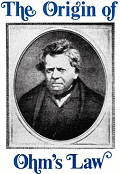 Georg Simon Ohm's eponymous "law," i.e.,
Ohm's law, is perhaps the best-known formula in the realm of electricity and electronics.
Although Mr. Ohm did not know it at the time, his conclusion holds up in both
the macro and micro scale worlds of electron behavior. Voltage is equal to the product
of a resistance and the current flowing through it, E = I * R.
It is hard to believe that we have only had his result, announced in 1825, at our
disposal for less than 200 years. A thorough grasp of Ohm's law is a minimum requirement
for entry into the fields of electrical and electronics work; fortunately, only
a fundamental grasp of algebra is required. Kirchhoff's law is a relatively easy
next step. The big hurdle comes with wanting to get an engineering degree where
mastery of Maxwell's equations and the calculus necessary to work with the formulas
in their various forms. Mr. David L. Heiserman published this brief lesson on "The
Origin of Ohm's Law," in the May 1972 issue of Popular Electronics
magazine... Georg Simon Ohm's eponymous "law," i.e.,
Ohm's law, is perhaps the best-known formula in the realm of electricity and electronics.
Although Mr. Ohm did not know it at the time, his conclusion holds up in both
the macro and micro scale worlds of electron behavior. Voltage is equal to the product
of a resistance and the current flowing through it, E = I * R.
It is hard to believe that we have only had his result, announced in 1825, at our
disposal for less than 200 years. A thorough grasp of Ohm's law is a minimum requirement
for entry into the fields of electrical and electronics work; fortunately, only
a fundamental grasp of algebra is required. Kirchhoff's law is a relatively easy
next step. The big hurdle comes with wanting to get an engineering degree where
mastery of Maxwell's equations and the calculus necessary to work with the formulas
in their various forms. Mr. David L. Heiserman published this brief lesson on "The
Origin of Ohm's Law," in the May 1972 issue of Popular Electronics
magazine...
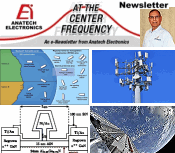 Sam Benzacar of Anatech Electronics, an
RF and microwave filter company, has published his January 2024 newsletter that,
along with timely news items, features his short op−ed entitled "Shadow
Warriors: Unmanned Aerial Vehicles Reshape the Battlefield." In it, he discusses
how drones (aka Unmanned Aerial Vehicles) are rapidly replacing human presence in
war fighting. These semiautonomous surveillance and/or weapons delivery platforms
are at the leading edge of technology, and unlike their flesh and blood counterparts,
have no conscience or fear. Sort of like with the V−1 Buzz Bombs that the Nazis
sent to rain down indiscriminate terror on London during the early days of World
War II, these UAVs do not provide much advance notice. These large drones have
noisy internal combustion or jet engines that can at least be heard a short ways
off. I wonder whether any of the highly classified system elements from RQ-170 UAV
that the Iranians hijacked in 2011 were incorporated into the drone that just killed
three American soldiers and wounded many others? I still don't know why we didn't
bomb the @(%^#>$ out of them at the time. Instead, we delivered >$400M in
cash... Sam Benzacar of Anatech Electronics, an
RF and microwave filter company, has published his January 2024 newsletter that,
along with timely news items, features his short op−ed entitled "Shadow
Warriors: Unmanned Aerial Vehicles Reshape the Battlefield." In it, he discusses
how drones (aka Unmanned Aerial Vehicles) are rapidly replacing human presence in
war fighting. These semiautonomous surveillance and/or weapons delivery platforms
are at the leading edge of technology, and unlike their flesh and blood counterparts,
have no conscience or fear. Sort of like with the V−1 Buzz Bombs that the Nazis
sent to rain down indiscriminate terror on London during the early days of World
War II, these UAVs do not provide much advance notice. These large drones have
noisy internal combustion or jet engines that can at least be heard a short ways
off. I wonder whether any of the highly classified system elements from RQ-170 UAV
that the Iranians hijacked in 2011 were incorporated into the drone that just killed
three American soldiers and wounded many others? I still don't know why we didn't
bomb the @(%^#>$ out of them at the time. Instead, we delivered >$400M in
cash...
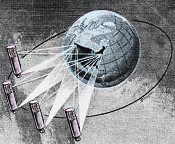 Author Len Buckwalter states in this 1972
"Communications
Satellites" article from Popular Electronics magazine that at the time,
radio channels were so crowded in California that police were using spectrum in
the television broadcast band for communication. The FCC was denying recreational
boaters channel space on favor of commercial operators. The problem could not be
blamed on available frequency space, but rather on the lack of inexpensive electronic
components that worked above a kHz or so. Nowadays when you read in the news about
such desperate need of spectrum that network owners pay millions or billions of
dollars for a few measly MHz of bandwidth, the cause is truly an overabundance of
devices vying for space. Although truthfully, you could claim that exactly the same
scenario is playing out today while semiconductor companies strive to bring low
cost components in the millimeter wave bands above 30 GHz... Author Len Buckwalter states in this 1972
"Communications
Satellites" article from Popular Electronics magazine that at the time,
radio channels were so crowded in California that police were using spectrum in
the television broadcast band for communication. The FCC was denying recreational
boaters channel space on favor of commercial operators. The problem could not be
blamed on available frequency space, but rather on the lack of inexpensive electronic
components that worked above a kHz or so. Nowadays when you read in the news about
such desperate need of spectrum that network owners pay millions or billions of
dollars for a few measly MHz of bandwidth, the cause is truly an overabundance of
devices vying for space. Although truthfully, you could claim that exactly the same
scenario is playing out today while semiconductor companies strive to bring low
cost components in the millimeter wave bands above 30 GHz...
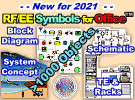 It was a lot of work, but I finally finished
a version of the "RF &
Electronics Schematic & Block Diagram Symbols"" that works well with Microsoft
Office™ programs Word™, Excel™, and Power Point™. This is an equivalent of the extensive
set of amplifier, mixer, filter, switch, connector, waveguide, digital, analog,
antenna, and other commonly used symbols for system block diagrams and schematics
created for Visio™. Each of the 1,000 or so symbols was exported individually from
Visio in the EMF file format, then imported into Word on a Drawing Canvas. The EMF
format allows an image to be scaled up or down without becoming pixelated, so all
the shapes can be resized in a document and still look good. The imported symbols
can also be UnGrouped into their original constituent parts for editing. Check them
out! It was a lot of work, but I finally finished
a version of the "RF &
Electronics Schematic & Block Diagram Symbols"" that works well with Microsoft
Office™ programs Word™, Excel™, and Power Point™. This is an equivalent of the extensive
set of amplifier, mixer, filter, switch, connector, waveguide, digital, analog,
antenna, and other commonly used symbols for system block diagrams and schematics
created for Visio™. Each of the 1,000 or so symbols was exported individually from
Visio in the EMF file format, then imported into Word on a Drawing Canvas. The EMF
format allows an image to be scaled up or down without becoming pixelated, so all
the shapes can be resized in a document and still look good. The imported symbols
can also be UnGrouped into their original constituent parts for editing. Check them
out!
Tuesday the 30th
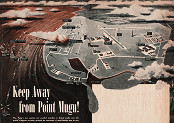 Just about anyone familiar with the
Electronic Warfare and Radar Systems Engineering Handbook, a must-have resource
back in the 1980s(?) and up through even today, knows it was published by the Naval
Air Warfare Center's Weapons Division Avionics Department, Electronic Warfare Division
at Point Mugu, California. I don't know when the first edition was put out, but
the most recent is 2013. My introduction to it was after arriving at General Electric's
Aerospace Electronic Systems Division, in Utica, New York, right after graduating
from the University of Vermont in 1989. It was, and still is, a valuable resource
for RF and microwave systems design. This 1948 issue of Popular Science
magazine contained an article entitled, "Keep
Away from Point Mugu!," to inform the public of the dangerous airborne weapons
systems being developed and tested there. Remotely controlled and self-piloted missiles
and drones, radar systems, secure communications systems, and other highly advanced,
top secret projects were and still are to this day in process... Just about anyone familiar with the
Electronic Warfare and Radar Systems Engineering Handbook, a must-have resource
back in the 1980s(?) and up through even today, knows it was published by the Naval
Air Warfare Center's Weapons Division Avionics Department, Electronic Warfare Division
at Point Mugu, California. I don't know when the first edition was put out, but
the most recent is 2013. My introduction to it was after arriving at General Electric's
Aerospace Electronic Systems Division, in Utica, New York, right after graduating
from the University of Vermont in 1989. It was, and still is, a valuable resource
for RF and microwave systems design. This 1948 issue of Popular Science
magazine contained an article entitled, "Keep
Away from Point Mugu!," to inform the public of the dangerous airborne weapons
systems being developed and tested there. Remotely controlled and self-piloted missiles
and drones, radar systems, secure communications systems, and other highly advanced,
top secret projects were and still are to this day in process...
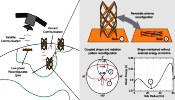 "Researchers from Stanford and the American
University of Beirut have developed a lightweight,
portable antenna that can communicate with satellites and devices on the ground,
making it easier to coordinate rescue and relief efforts in disaster-prone areas.
When an earthquake, flood, or other disaster strikes a region, existing communication
infrastructure such as cell phone and radio towers are often damaged or destroyed.
Restoring emergency communications as quickly as possible is vital for coordinating
rescue and relief efforts. Researchers at Stanford University and the American University
of Beirut (AUB) have developed a portable antenna that could be quickly deployed
in disaster-prone areas or used to set up communications in underdeveloped regions.
The antenna, described recently in Nature Communications, packs down to a small
size and can easily shift between two configurations to communicate either with
satellites or devices on the ground without using additional power..." "Researchers from Stanford and the American
University of Beirut have developed a lightweight,
portable antenna that can communicate with satellites and devices on the ground,
making it easier to coordinate rescue and relief efforts in disaster-prone areas.
When an earthquake, flood, or other disaster strikes a region, existing communication
infrastructure such as cell phone and radio towers are often damaged or destroyed.
Restoring emergency communications as quickly as possible is vital for coordinating
rescue and relief efforts. Researchers at Stanford University and the American University
of Beirut (AUB) have developed a portable antenna that could be quickly deployed
in disaster-prone areas or used to set up communications in underdeveloped regions.
The antenna, described recently in Nature Communications, packs down to a small
size and can easily shift between two configurations to communicate either with
satellites or devices on the ground without using additional power..."
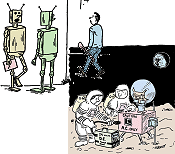 Here are two more
tech-themed comics from vintage Popular Electronics magazines. The
year was 1972, which was at the peak of NASA's Project Apollo moon manned exploration
era. Unfortunately, unbeknownst to the agency at the time, it was also near the
end of the era as the moon exploration portion of the program was abruptly cancelled
after Apollo 17, in December of 1972. No man has set foot on the moon since
then - 45 years as of this writing. One of the comics humorously depicts a situation
that for many government departments would be a "situation normal" scenario, but
given NASA's overwhelming success, it would not be as expected. The other comic
deals with a workplace concept that, while much more "futuristic" at the time, is
rapidly becoming a concern of workers today where even fast food workers are being
replaced by robots... Here are two more
tech-themed comics from vintage Popular Electronics magazines. The
year was 1972, which was at the peak of NASA's Project Apollo moon manned exploration
era. Unfortunately, unbeknownst to the agency at the time, it was also near the
end of the era as the moon exploration portion of the program was abruptly cancelled
after Apollo 17, in December of 1972. No man has set foot on the moon since
then - 45 years as of this writing. One of the comics humorously depicts a situation
that for many government departments would be a "situation normal" scenario, but
given NASA's overwhelming success, it would not be as expected. The other comic
deals with a workplace concept that, while much more "futuristic" at the time, is
rapidly becoming a concern of workers today where even fast food workers are being
replaced by robots...
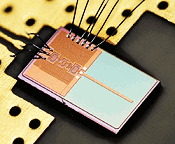 "With higher frequencies, the integration
of antennas and RF electronics means that many measurements now must be performed
over the air. This article addresses the challenges of testing integrated antenna
systems in e.g. phased array,
antenna-on-chip and antenna-in-package configurations. This article details
the latest over-the-air (OTA) measurement techniques for metrics such as noise figure,
out-of-band emissions and radiated power spectral density. An ongoing trend in the
mmWave regime is towards highly integrated wireless system designs. These efforts
are being undertaken to reduce costs and increase efficiency. This integration often
means that the antenna and the RF electronics cannot be separated, creating a new
dimension in testing RF front-end performance. Some of the most integrated designs
involve antennas-on-chip or antennas-in-package, which are becoming especially popular
in high frequency applications, such as automotive radar. Figure 1 shows a 2×1 mm,
30 GHz monopole antenna integrated with a low noise amplifier..." "With higher frequencies, the integration
of antennas and RF electronics means that many measurements now must be performed
over the air. This article addresses the challenges of testing integrated antenna
systems in e.g. phased array,
antenna-on-chip and antenna-in-package configurations. This article details
the latest over-the-air (OTA) measurement techniques for metrics such as noise figure,
out-of-band emissions and radiated power spectral density. An ongoing trend in the
mmWave regime is towards highly integrated wireless system designs. These efforts
are being undertaken to reduce costs and increase efficiency. This integration often
means that the antenna and the RF electronics cannot be separated, creating a new
dimension in testing RF front-end performance. Some of the most integrated designs
involve antennas-on-chip or antennas-in-package, which are becoming especially popular
in high frequency applications, such as automotive radar. Figure 1 shows a 2×1 mm,
30 GHz monopole antenna integrated with a low noise amplifier..."
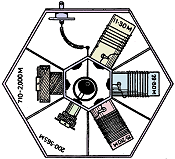 "All-wave" radios were all the rage in the
1930s. Such technological marvels (they truly were back in the day) gave listeners
access to not just local commercial broadcasts, but to radio stations around the
world. Farm families and suburb dwellers suddenly became nouveau cosmopolitans.
It was akin to how the Internet, aka the "Information Superhighway," provided on-demand
access to stored data in the 1990s. "Onramps" like RF Cafe provided organized, classified
venues for the teeming masses. But, I digress... Not only were new radios being
designed as all-wave, but tuning kits were sold for radio service shops to retrofit
existing sets. Covering such a wide spectrum of tuning required banks of selectable
inductors and capacitors. Supplying a one-size-fits-all module required adequate
shielding and isolation to minimize coupling to and from the all-wave tuner. This
unit was featured at the
1934 Paris Radio Exhibition... "All-wave" radios were all the rage in the
1930s. Such technological marvels (they truly were back in the day) gave listeners
access to not just local commercial broadcasts, but to radio stations around the
world. Farm families and suburb dwellers suddenly became nouveau cosmopolitans.
It was akin to how the Internet, aka the "Information Superhighway," provided on-demand
access to stored data in the 1990s. "Onramps" like RF Cafe provided organized, classified
venues for the teeming masses. But, I digress... Not only were new radios being
designed as all-wave, but tuning kits were sold for radio service shops to retrofit
existing sets. Covering such a wide spectrum of tuning required banks of selectable
inductors and capacitors. Supplying a one-size-fits-all module required adequate
shielding and isolation to minimize coupling to and from the all-wave tuner. This
unit was featured at the
1934 Paris Radio Exhibition...
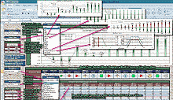 RF Cascade Workbook is the next phase in the evolution of RF Cafe's long-running
series, RF Cascade Workbook. Chances are you have never used a spreadsheet
quite like this (click
here for screen capture). It is a full-featured RF system cascade parameter
and frequency planner that includes filters and mixers for a mere $45. Built in
MS Excel, using RF Cascade Workbook 2018 is a cinch and the format
is entirely customizable. It is significantly easier and faster than using a multi-thousand
dollar simulator when a high level system analysis is all that is needed. An intro
video takes you through the main features...
RF Cascade Workbook is the next phase in the evolution of RF Cafe's long-running
series, RF Cascade Workbook. Chances are you have never used a spreadsheet
quite like this (click
here for screen capture). It is a full-featured RF system cascade parameter
and frequency planner that includes filters and mixers for a mere $45. Built in
MS Excel, using RF Cascade Workbook 2018 is a cinch and the format
is entirely customizable. It is significantly easier and faster than using a multi-thousand
dollar simulator when a high level system analysis is all that is needed. An intro
video takes you through the main features...
Monday the 29th
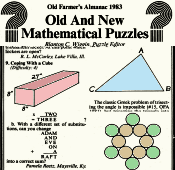 This set of "Old
and New Mathematical Puzzles" appeared in the 1983 issue of The Old Farmers
Almanac (OFA). In addition to daily times for sunrise and sunset, moonrise and moonset,
crop planting tables, animal gestation periods, significant events in history, weather
predictions and trends, and many other bits of actual scientific information, the
OFA included a set of puzzles requiring a wide range of mathematical and reasoning
skills to solve (Difficulty: 1 through 5). Difficulty: 1, might be something
like tracing the path along a geographical line drawing without crossing any lines.
Difficulty: 3, likely involves some degree of mathematics, often a bit of algebra
like solving three equations in three unknowns. Difficulty: 5, being the highest
level of challenge, typically does not have solutions provided as do the others.
Those solutions are solicited from readers and "the best" for each is published
in the next year of publication... This set of "Old
and New Mathematical Puzzles" appeared in the 1983 issue of The Old Farmers
Almanac (OFA). In addition to daily times for sunrise and sunset, moonrise and moonset,
crop planting tables, animal gestation periods, significant events in history, weather
predictions and trends, and many other bits of actual scientific information, the
OFA included a set of puzzles requiring a wide range of mathematical and reasoning
skills to solve (Difficulty: 1 through 5). Difficulty: 1, might be something
like tracing the path along a geographical line drawing without crossing any lines.
Difficulty: 3, likely involves some degree of mathematics, often a bit of algebra
like solving three equations in three unknowns. Difficulty: 5, being the highest
level of challenge, typically does not have solutions provided as do the others.
Those solutions are solicited from readers and "the best" for each is published
in the next year of publication...
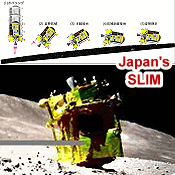 Ignorance is not bliss. Unfortunately, it
usually leads to a lot of bad information being widely propagated while those who
know the truth are frustrated by how often it occurs*. In this case it is the widely
reported "fact" that
Japan's SLIM moon lander ended its mission upside down on the lunar surface.
In fact, it was designed to tip after touching down (see drawing above), it just
unfortunately tipped too far. It is NOT, however, upside down. New was just received
that SLIM is functioning, but at a reduced battery charging rate due to solar panels
not pointed at the sun. The two detachable autonomous vehicles deployed successfully.
Good for Japan! *Akin to Trump supposedly saying "bigly" as an adjective when in
fact he often used the idiomatic phrase "big
league." As is often the case, it is the ignorant / stupid reporters who are
the true fools. Ignorance is not bliss. Unfortunately, it
usually leads to a lot of bad information being widely propagated while those who
know the truth are frustrated by how often it occurs*. In this case it is the widely
reported "fact" that
Japan's SLIM moon lander ended its mission upside down on the lunar surface.
In fact, it was designed to tip after touching down (see drawing above), it just
unfortunately tipped too far. It is NOT, however, upside down. New was just received
that SLIM is functioning, but at a reduced battery charging rate due to solar panels
not pointed at the sun. The two detachable autonomous vehicles deployed successfully.
Good for Japan! *Akin to Trump supposedly saying "bigly" as an adjective when in
fact he often used the idiomatic phrase "big
league." As is often the case, it is the ignorant / stupid reporters who are
the true fools.
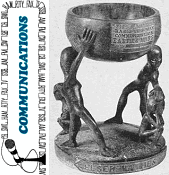 Planet Mars QSO - Visitors to the headquarters
of the American Radio Relay League, Inc. Newington, Conn., continue to be intrigued
by one of the most unusual trophies offered to ham radio operators, It is the Elser-Mathes
Cup that will commemorate the "First
Amateur Radio Two-Way Communications Earth and Mars." Donated by Colonel Fred
Elser, W6FB/W7OX and. Lt. Cmdr. Stanley Mathes, K1CY (deceased), the cup also honors
Hiram Percy Maxim (founder of the ARRL), who had an intense interest in communicating
with Mars and Venus. When donated to the ARRL in 1929, the idea of ham radio reaching
even the moon was considered impractical, but ham-style E-M-E (earth-moon-earth)
reflected communications are now almost commonplace. Maybe the first man on Mars
will be a ham. If so, his trophy is all ready and waiting for him... Planet Mars QSO - Visitors to the headquarters
of the American Radio Relay League, Inc. Newington, Conn., continue to be intrigued
by one of the most unusual trophies offered to ham radio operators, It is the Elser-Mathes
Cup that will commemorate the "First
Amateur Radio Two-Way Communications Earth and Mars." Donated by Colonel Fred
Elser, W6FB/W7OX and. Lt. Cmdr. Stanley Mathes, K1CY (deceased), the cup also honors
Hiram Percy Maxim (founder of the ARRL), who had an intense interest in communicating
with Mars and Venus. When donated to the ARRL in 1929, the idea of ham radio reaching
even the moon was considered impractical, but ham-style E-M-E (earth-moon-earth)
reflected communications are now almost commonplace. Maybe the first man on Mars
will be a ham. If so, his trophy is all ready and waiting for him...
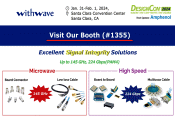 Withwave is a leading designer and developer
of a broad range of RF, microwave, and millimeter−wave test solutions and subsystems
with a focus on electromagnetic field analysis and signal processing. We invite
you to visit with us at
DesignCon 2024
in Booth #1355. Our team will be displaying Withwave's extensive line of precision
microwave and high speed test products, well suited for 5G and 6G systems, spanning
a frequency range of DC to 110 GHz. Included are connectors, cable assemblies,
test accessories, high speed multi coax, high speed connectors, calibration kits
and modules, absorber material, switch modules, antennas, E−band & sub−THz waveguide
components. DesignCon is being held at the Santa Clara Convention Center in Santa
Cara, California, on January 31 and February 1, 2024... Withwave is a leading designer and developer
of a broad range of RF, microwave, and millimeter−wave test solutions and subsystems
with a focus on electromagnetic field analysis and signal processing. We invite
you to visit with us at
DesignCon 2024
in Booth #1355. Our team will be displaying Withwave's extensive line of precision
microwave and high speed test products, well suited for 5G and 6G systems, spanning
a frequency range of DC to 110 GHz. Included are connectors, cable assemblies,
test accessories, high speed multi coax, high speed connectors, calibration kits
and modules, absorber material, switch modules, antennas, E−band & sub−THz waveguide
components. DesignCon is being held at the Santa Clara Convention Center in Santa
Cara, California, on January 31 and February 1, 2024...
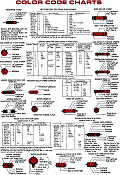 Here is one of the most complete component
color code charts that I have seen. It covers resistors, capacitors, and inductors
for EIA, JAN, and commercial standards. If you are reading this, you have almost
certainly memorized the color / number correlation (BBROYGBVGW = 0123456789, respectively)
and know how to read a regular carbon resistor's code for resistance and maybe even
tolerance. However, if you encounter a capacitor with an array of colored dots or
a component with 5 colored bands, are you sure how to read it? This handy-dandy
chart will help. Or, you probably have an app on your phone that will do the same
thing. In 1972 when the chart appeared in Popular Electronics magazine, nobody had
ever conceived of a phone app... Here is one of the most complete component
color code charts that I have seen. It covers resistors, capacitors, and inductors
for EIA, JAN, and commercial standards. If you are reading this, you have almost
certainly memorized the color / number correlation (BBROYGBVGW = 0123456789, respectively)
and know how to read a regular carbon resistor's code for resistance and maybe even
tolerance. However, if you encounter a capacitor with an array of colored dots or
a component with 5 colored bands, are you sure how to read it? This handy-dandy
chart will help. Or, you probably have an app on your phone that will do the same
thing. In 1972 when the chart appeared in Popular Electronics magazine, nobody had
ever conceived of a phone app...
 Banner Ads are rotated in all locations
on the page! RF Cafe typically receives 8,000-15,000 visits each
weekday. RF Cafe
is a favorite of engineers, technicians, hobbyists, and students all over the world.
With more than 17,000 pages in the Google search index, RF Cafe returns in
favorable positions on many types of key searches, both for text and images.
Your Banner Ads are displayed on average 280,000 times per year! New content
is added on a daily basis, which keeps the major search engines interested enough
to spider it multiple times each day. Items added on the homepage often can be found
in a Google search within a few hours of being posted. If you need your company news to be seen, RF Cafe is the
place to be... Banner Ads are rotated in all locations
on the page! RF Cafe typically receives 8,000-15,000 visits each
weekday. RF Cafe
is a favorite of engineers, technicians, hobbyists, and students all over the world.
With more than 17,000 pages in the Google search index, RF Cafe returns in
favorable positions on many types of key searches, both for text and images.
Your Banner Ads are displayed on average 280,000 times per year! New content
is added on a daily basis, which keeps the major search engines interested enough
to spider it multiple times each day. Items added on the homepage often can be found
in a Google search within a few hours of being posted. If you need your company news to be seen, RF Cafe is the
place to be...
Sunday the 28th
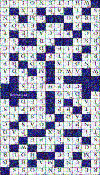 Here is RF Cafe's
electronics-themed crossword puzzle for January 28th. All RF Cafe crossword
puzzles are custom made by me, Kirt Blattenberger, and have only words and clues
related to RF, microwave, and mm-wave engineering, optics, mathematics, chemistry,
physics, and other technical subjects. As always, this crossword contains no names
of politicians, mountain ranges, exotic foods or plants, movie stars, or anything
of the sort unless it/he/she is related to this puzzle's technology theme (e.g.,
Reginald Denny, Hedy Lamarr, or the Tunguska event in Siberia). The technically
inclined cruciverbalists amongst us will appreciate the effort. Enjoy! Here is RF Cafe's
electronics-themed crossword puzzle for January 28th. All RF Cafe crossword
puzzles are custom made by me, Kirt Blattenberger, and have only words and clues
related to RF, microwave, and mm-wave engineering, optics, mathematics, chemistry,
physics, and other technical subjects. As always, this crossword contains no names
of politicians, mountain ranges, exotic foods or plants, movie stars, or anything
of the sort unless it/he/she is related to this puzzle's technology theme (e.g.,
Reginald Denny, Hedy Lamarr, or the Tunguska event in Siberia). The technically
inclined cruciverbalists amongst us will appreciate the effort. Enjoy!
Friday the 26th
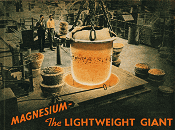 The mention of
magnesium (Mg) often - maybe usually - invokes thoughts of a material that spontaneously
bursts into flames when it comes into contact with water. It is true when a non-oxidized
Mg surface meets water, but a protective layer of oxide quickly forms on surfaces
exposed to air, rendering it inert. In fact, the machining process continuously
exposes raw magnesium, so special precautionary processes are required. This story
about the Basic Magnesium, Inc. (BMI) magnesium processing plant just a few miles
from the Boulder Dam (now called the Hoover Dam) in Nevada (from which it consumed
a third of its generating capacity) appeared in a 1944 issue of Popular Mechanics
magazine. At a third the weight of steel (atomic #12), magnesium was a critical
component of aircraft structures and engines during World War II. Vast amounts
of electric power was required, as evidenced by this passage: "BMI borrowed some
20,000 tons of coin silver from the Treasury, shaped it into metal planks to serve
as electrical bus bars, and installed it in the plant. The silver is worth $23,313,000
and will be returned to the Treasury after the war. It is perfectly safe where it
is in spite of its value. No one would dare to touch it, considering the heavy current
that it carries..." The mention of
magnesium (Mg) often - maybe usually - invokes thoughts of a material that spontaneously
bursts into flames when it comes into contact with water. It is true when a non-oxidized
Mg surface meets water, but a protective layer of oxide quickly forms on surfaces
exposed to air, rendering it inert. In fact, the machining process continuously
exposes raw magnesium, so special precautionary processes are required. This story
about the Basic Magnesium, Inc. (BMI) magnesium processing plant just a few miles
from the Boulder Dam (now called the Hoover Dam) in Nevada (from which it consumed
a third of its generating capacity) appeared in a 1944 issue of Popular Mechanics
magazine. At a third the weight of steel (atomic #12), magnesium was a critical
component of aircraft structures and engines during World War II. Vast amounts
of electric power was required, as evidenced by this passage: "BMI borrowed some
20,000 tons of coin silver from the Treasury, shaped it into metal planks to serve
as electrical bus bars, and installed it in the plant. The silver is worth $23,313,000
and will be returned to the Treasury after the war. It is perfectly safe where it
is in spite of its value. No one would dare to touch it, considering the heavy current
that it carries..."
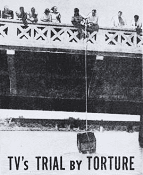 No, it's not a college engineering class
prank like the yearly
piano drop at MIT's Baker House or University of British Columbia in Vancouver
engineering students dangling a VW Bug from the Golden Gate Bridge. This is water
"dunking" test carried out by a television manufacturer to assure that its products
can survive an accidental exposure to moisture. I assume the water below is fresh
water and not salt water. Vacuum tube TV sets were at a great disadvantage for survivability
compared to modern solid state sets with LCD displays. Even if the glass itself
remains intact, precisely aligned internal elements like deflection coils, grid
and plate structures can shift position and change both alignment and affect reliability.
Also, in the mid 1950s there was still a lot of point-to-point wiring of components
that had them suspended in air by their leads, resulting in mechanical fatigue.
The "walking wounded" phenomenon would result in a TV giving up the ghost earlier
than it otherwise might... No, it's not a college engineering class
prank like the yearly
piano drop at MIT's Baker House or University of British Columbia in Vancouver
engineering students dangling a VW Bug from the Golden Gate Bridge. This is water
"dunking" test carried out by a television manufacturer to assure that its products
can survive an accidental exposure to moisture. I assume the water below is fresh
water and not salt water. Vacuum tube TV sets were at a great disadvantage for survivability
compared to modern solid state sets with LCD displays. Even if the glass itself
remains intact, precisely aligned internal elements like deflection coils, grid
and plate structures can shift position and change both alignment and affect reliability.
Also, in the mid 1950s there was still a lot of point-to-point wiring of components
that had them suspended in air by their leads, resulting in mechanical fatigue.
The "walking wounded" phenomenon would result in a TV giving up the ghost earlier
than it otherwise might...
 "Scientists have made a breakthrough in
nanophotonics by developing a method to measure nanoscale light interaction, paving
the way for advancements in quantum computing and medical diagnostics. In an era
where understanding and manipulating light at the nanoscale is increasingly crucial,
a groundbreaking paper in Nature: Light Science & Applications reveals a significant
leap forward. A team of scientists from the Institut Langevin, ESPCI Paris, PSL
University, CNRS have developed a sophisticated method to measure the enhancement
of light interaction at the nanoscale using single molecules as probes. Central
to this research are
dielectric gap nanoantennas - developed and fabricated at the Imperial College
London. Such structures are made of gallium phosphide (GaP), a material chosen for
its high refractive index and low optical losses. This collaborative work involves
an innovative approach using single molecules to probe the enhanced interaction
of light facilitated purely by these nanoantennas without modification of the nanosystem
with near-field probes..." "Scientists have made a breakthrough in
nanophotonics by developing a method to measure nanoscale light interaction, paving
the way for advancements in quantum computing and medical diagnostics. In an era
where understanding and manipulating light at the nanoscale is increasingly crucial,
a groundbreaking paper in Nature: Light Science & Applications reveals a significant
leap forward. A team of scientists from the Institut Langevin, ESPCI Paris, PSL
University, CNRS have developed a sophisticated method to measure the enhancement
of light interaction at the nanoscale using single molecules as probes. Central
to this research are
dielectric gap nanoantennas - developed and fabricated at the Imperial College
London. Such structures are made of gallium phosphide (GaP), a material chosen for
its high refractive index and low optical losses. This collaborative work involves
an innovative approach using single molecules to probe the enhanced interaction
of light facilitated purely by these nanoantennas without modification of the nanosystem
with near-field probes..."
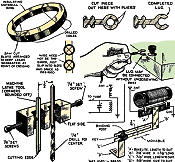 Here for radio hobbyists are eleven
handy-dandy "kinks," otherwise known as tricks, shortcuts, or clever ideas,
that could prove useful while working in the lab at work or in your shop at home.
This set appeared in the June 1935 issue of Short Wave Craft magazine.
Some of the ideas presented are timeless, but admittedly, most of these ideas would
not have much application with today's ready-made radios, antennas, power supplies,
etc. There are still people, though, who build custom equipment and/or repair vintage
equipment who might find them useful. The most relevant kink offered here that could
come in handy for anybody is to clip off part of a closed ring terminal lug to allow
it to be installed and uninstalled without needing to remove the cinching nut and
possibly other lugs also on the same binding post... Here for radio hobbyists are eleven
handy-dandy "kinks," otherwise known as tricks, shortcuts, or clever ideas,
that could prove useful while working in the lab at work or in your shop at home.
This set appeared in the June 1935 issue of Short Wave Craft magazine.
Some of the ideas presented are timeless, but admittedly, most of these ideas would
not have much application with today's ready-made radios, antennas, power supplies,
etc. There are still people, though, who build custom equipment and/or repair vintage
equipment who might find them useful. The most relevant kink offered here that could
come in handy for anybody is to clip off part of a closed ring terminal lug to allow
it to be installed and uninstalled without needing to remove the cinching nut and
possibly other lugs also on the same binding post...
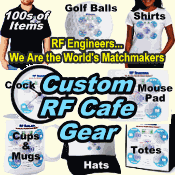 This assortment of custom-designed themes
by RF Cafe includes T-Shirts, Mouse Pads, Clocks, Tote Bags, Coffee Mugs and Steins,
Purses, Sweatshirts, Baseball Caps, and more, all sporting my amazingly clever "RF Engineers - We Are the World's
Matchmakers" Smith chart design. These would make excellent gifts for husbands,
wives, kids, significant others, and for handing out at company events or as rewards
for excellent service. My graphic has been ripped off by other people and used on
their products, so please be sure to purchase only official RF Cafe gear. I only
make a couple bucks on each sale - the rest goes to Cafe Press. It's a great way
to help support RF Cafe. Thanks... This assortment of custom-designed themes
by RF Cafe includes T-Shirts, Mouse Pads, Clocks, Tote Bags, Coffee Mugs and Steins,
Purses, Sweatshirts, Baseball Caps, and more, all sporting my amazingly clever "RF Engineers - We Are the World's
Matchmakers" Smith chart design. These would make excellent gifts for husbands,
wives, kids, significant others, and for handing out at company events or as rewards
for excellent service. My graphic has been ripped off by other people and used on
their products, so please be sure to purchase only official RF Cafe gear. I only
make a couple bucks on each sale - the rest goes to Cafe Press. It's a great way
to help support RF Cafe. Thanks...
Thursday the 25th
 If you think this
Zenith Radio advertisement looks familiar, it could be because you recently
saw it on the October 1942 Popular Mechanics magazine table of contents
page. Or not. Nearly a year after the United States of America shifted industry
production to a wartime footing, no factories were turning out new radio sets for
domestic use. The only new radios being made were for Army and Navy use in fighting
to defeat Axis forces in Europe, North Africa, and the South Pacific. The ad quotes
General (a mere Lt. Colonel prior to the raid) Doolittle's radio broadcast following
his air group's raid of Japan's capital city, Tokyo, on April 18th of that year.
The Doolittle Raid, as it is known, was the first attack on the Japanese homeland
since the surprise attack by their navy on Pearl Harbor. Doolittle's Raiders managed
to launch sixteen Mitchell B-25 bombers from the deck of the USS Hornet carrier
- a feat never before attempted. Zenith also extolls the superiority of radio communications
over wired comms due to its potential worldwide reach without the need of cumbersome
and vulnerable landlines... If you think this
Zenith Radio advertisement looks familiar, it could be because you recently
saw it on the October 1942 Popular Mechanics magazine table of contents
page. Or not. Nearly a year after the United States of America shifted industry
production to a wartime footing, no factories were turning out new radio sets for
domestic use. The only new radios being made were for Army and Navy use in fighting
to defeat Axis forces in Europe, North Africa, and the South Pacific. The ad quotes
General (a mere Lt. Colonel prior to the raid) Doolittle's radio broadcast following
his air group's raid of Japan's capital city, Tokyo, on April 18th of that year.
The Doolittle Raid, as it is known, was the first attack on the Japanese homeland
since the surprise attack by their navy on Pearl Harbor. Doolittle's Raiders managed
to launch sixteen Mitchell B-25 bombers from the deck of the USS Hornet carrier
- a feat never before attempted. Zenith also extolls the superiority of radio communications
over wired comms due to its potential worldwide reach without the need of cumbersome
and vulnerable landlines...
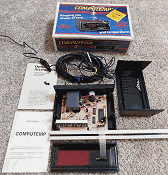 After decades of using various outdoor thermometers
that used a bimetal coil, mercury, or alcohol, I finally decided after the latest
one failed that it was time to get an electronic one. Not wanting a wireless type
that would require batteries, I found a vintage thermometer on eBay that had a remote
alcohol bulb connected to the indoor display by a thin copper tube. When it arrived,
I discovered that the bulb had burst long ago, and the escaped red dye in the alcohol
was evident on the packaging. At that point I figured maybe an electronic thermometer
using remote thermocouple sensors would be a good option, since being directly wired
to the indoor display unit, no batteries would be required. My first choice for
a vintage electronic thermometer was one of the Heathkit models, preferably unbuilt,
but a pre-built version would be acceptable. After about a week of keeping a watch
out for one, none became available, so I looked for something else. This
CompuTemp 5 electronic thermometer was offered by a few different eBay
sellers. The one I selected appeared to be never used and it had the original packaging... After decades of using various outdoor thermometers
that used a bimetal coil, mercury, or alcohol, I finally decided after the latest
one failed that it was time to get an electronic one. Not wanting a wireless type
that would require batteries, I found a vintage thermometer on eBay that had a remote
alcohol bulb connected to the indoor display by a thin copper tube. When it arrived,
I discovered that the bulb had burst long ago, and the escaped red dye in the alcohol
was evident on the packaging. At that point I figured maybe an electronic thermometer
using remote thermocouple sensors would be a good option, since being directly wired
to the indoor display unit, no batteries would be required. My first choice for
a vintage electronic thermometer was one of the Heathkit models, preferably unbuilt,
but a pre-built version would be acceptable. After about a week of keeping a watch
out for one, none became available, so I looked for something else. This
CompuTemp 5 electronic thermometer was offered by a few different eBay
sellers. The one I selected appeared to be never used and it had the original packaging...
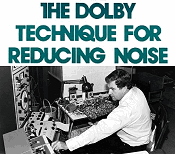 Those of us who came of age in the early
1970s are very familiar with the
Dolby B noise reduction system since it was the key differentiator when buying
stereo equipment in the day. The first commercial products containing the technology
appeared in 1968. I am fairly certain that neither I nor any of my friends who insisted
on tape decks with the Dolby logo on them had any idea how the circuit worked. At
the time to us, filters were those fan-folded things on top of a carburetor and
feedback was the annoying squeal that happened when a microphone got too close to
a speaker. Knowledge of electronic circuits would begin a few years later. This
article which appeared in a 1972 issue of Popular Electronics magazine does a nice
job of introducing the theory (in layman's terms) behind Dolby noise reduction.
There were no digital circuits, nor computers fast enough in 1968 to do the job,
so everything was implemented in analog circuitry... Those of us who came of age in the early
1970s are very familiar with the
Dolby B noise reduction system since it was the key differentiator when buying
stereo equipment in the day. The first commercial products containing the technology
appeared in 1968. I am fairly certain that neither I nor any of my friends who insisted
on tape decks with the Dolby logo on them had any idea how the circuit worked. At
the time to us, filters were those fan-folded things on top of a carburetor and
feedback was the annoying squeal that happened when a microphone got too close to
a speaker. Knowledge of electronic circuits would begin a few years later. This
article which appeared in a 1972 issue of Popular Electronics magazine does a nice
job of introducing the theory (in layman's terms) behind Dolby noise reduction.
There were no digital circuits, nor computers fast enough in 1968 to do the job,
so everything was implemented in analog circuitry...
 "Researchers have developed a semiconductor
device made of diamond, offering a promising solution for achieving carbon neutrality
by 2050. This device boasts the highest breakdown voltage and lowest leakage current
compared to existing
diamond devices, marking a significant advancement in the electrification process.
To reach the world's goal of carbon neutrality by 2050, there must be a fundamental
change in electronic materials to create a more reliable and resilient electricity
grid. A diamond might be a girl's best friend, but it might also be the solution
needed to sustain the electrification of society needed to reach carbon neutrality
in the next 30 years. Researchers at the University of Illinois Urbana-Champaign
have developed a semiconductor device made using diamond, that has the highest breakdown
voltage and lowest leakage current compared to previously reported diamond devices.
Such a device will enable more efficient technologies needed as the world transitions
to renewable energies. The Rising Demand for Electricity It is estimated that currently,
50% of the world's electricity is controlled by power devices..." "Researchers have developed a semiconductor
device made of diamond, offering a promising solution for achieving carbon neutrality
by 2050. This device boasts the highest breakdown voltage and lowest leakage current
compared to existing
diamond devices, marking a significant advancement in the electrification process.
To reach the world's goal of carbon neutrality by 2050, there must be a fundamental
change in electronic materials to create a more reliable and resilient electricity
grid. A diamond might be a girl's best friend, but it might also be the solution
needed to sustain the electrification of society needed to reach carbon neutrality
in the next 30 years. Researchers at the University of Illinois Urbana-Champaign
have developed a semiconductor device made using diamond, that has the highest breakdown
voltage and lowest leakage current compared to previously reported diamond devices.
Such a device will enable more efficient technologies needed as the world transitions
to renewable energies. The Rising Demand for Electricity It is estimated that currently,
50% of the world's electricity is controlled by power devices..."
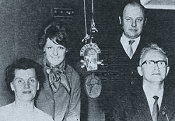 "DXing" is
amateur radio shorthand for long distance communications. While there is no formal
exact distance beyond which an operator has officially made a 'long distance' contact,
a generally accepted range is maybe 50 miles or so. To some extent, DX is relative
to the equipment and power being used. For instance if you have a maximum legal
transmitter output power of 1500 watts and an optimally sited, mounted and tuned,
high gain antenna, with low loss transmission cable, and super sensitive receiver,
etc., and make a successful contact 100 miles away, no one would give you kudos
for your effort. However, if you managed the same result using a handheld transceiver
with a 'rubber duck' stub antenna while walking through a deep valley, you would
be considered a DX superman. This article describes a much more rare and difficult
means of making DX contacts and collecting QSL cards - bodily travelling across
the globe to visit other amateur radio operators at their home bases (although I'm
not sure doing so qualifies for a QSL card unless radio contact is made)... "DXing" is
amateur radio shorthand for long distance communications. While there is no formal
exact distance beyond which an operator has officially made a 'long distance' contact,
a generally accepted range is maybe 50 miles or so. To some extent, DX is relative
to the equipment and power being used. For instance if you have a maximum legal
transmitter output power of 1500 watts and an optimally sited, mounted and tuned,
high gain antenna, with low loss transmission cable, and super sensitive receiver,
etc., and make a successful contact 100 miles away, no one would give you kudos
for your effort. However, if you managed the same result using a handheld transceiver
with a 'rubber duck' stub antenna while walking through a deep valley, you would
be considered a DX superman. This article describes a much more rare and difficult
means of making DX contacts and collecting QSL cards - bodily travelling across
the globe to visit other amateur radio operators at their home bases (although I'm
not sure doing so qualifies for a QSL card unless radio contact is made)...
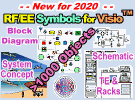 With more than 1000
custom-built symbols, this has got to be the most comprehensive set of
Visio Symbols
available for RF, analog, and digital system and schematic drawings! Every object
has been built to fit proportionally on the provided A-, B- and C-size drawing page
templates (or can use your own). Symbols are provided for equipment racks and test
equipment, system block diagrams, conceptual drawings, and schematics. Unlike previous
versions, these are NOT Stencils, but instead are all contained on tabbed pages
within a single Visio document. That puts everything in front of you in its full
glory. Just copy and paste what you need on your drawing. The file format is XML
so everything plays nicely with Visio 2013 and later... With more than 1000
custom-built symbols, this has got to be the most comprehensive set of
Visio Symbols
available for RF, analog, and digital system and schematic drawings! Every object
has been built to fit proportionally on the provided A-, B- and C-size drawing page
templates (or can use your own). Symbols are provided for equipment racks and test
equipment, system block diagrams, conceptual drawings, and schematics. Unlike previous
versions, these are NOT Stencils, but instead are all contained on tabbed pages
within a single Visio document. That puts everything in front of you in its full
glory. Just copy and paste what you need on your drawing. The file format is XML
so everything plays nicely with Visio 2013 and later...
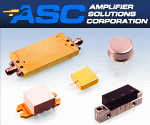 Amplifier Solutions Corporation (ASC) is
a manufacturer of amplifiers for commercial & military markets. ASC designs
and manufactures hybrid, surface mount flange, open carrier and connectorized amplifiers
for low, medium and high power applications using Gallium Nitride (GaN), Gallium
Arsenide (GaAs) and Silicon (Si) transistor technologies. ASC's thick film designs
operate in the frequency range of 300 kHz to 6 GHz. ASC offers thin film
designs that operate up to 20 GHz. ASC is located in an 8,000 sq.ft. facility
in the town of Telford, PA. We offer excellent customer support and take pride in
the ability to quickly react to evolving system design requirements. Amplifier Solutions Corporation (ASC) is
a manufacturer of amplifiers for commercial & military markets. ASC designs
and manufactures hybrid, surface mount flange, open carrier and connectorized amplifiers
for low, medium and high power applications using Gallium Nitride (GaN), Gallium
Arsenide (GaAs) and Silicon (Si) transistor technologies. ASC's thick film designs
operate in the frequency range of 300 kHz to 6 GHz. ASC offers thin film
designs that operate up to 20 GHz. ASC is located in an 8,000 sq.ft. facility
in the town of Telford, PA. We offer excellent customer support and take pride in
the ability to quickly react to evolving system design requirements.
Wednesday the 24th
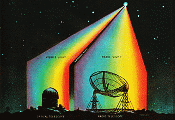 In 1933, Karl Jansky, at Bell Telephone
Laboratories, reported electromagnetic radiation coming from the center of our Milky
Way galaxy in the direction of Sagittarius. It was the first time radio signals
were knowingly detected in space. This, by the way, was not the cosmic microwave
background radiation (CMBR) that Penzias and Wilson discovered, also at Bell Labs,
in 1964. Reported in this 1954 issue of Popular Science magazine are advances
made in
radio astronomy since the early efforts to detect and map the radio sky as a
supplement to the visible light map. In most cases at the time, "radio stars" were
coincident with known visible light stars; however, new stars were discovered which
had no visible signature. Since that time, with the advent of larger telescopes
and vastly more sensitive light detectors, many of those radio-only stars have been
determined to also have a visible light component. Quite interestingly, the author
mentions, "Many radio stars outshine the sun in radio 'brightness.' A bright one
in the constellation of Cygnus, the Swan, was the first discovered, by Australian
observers." Could this have been Cygnus X-1, the first x-ray star determined to
be a black hole, which was discovered in 1971? In 1933, Karl Jansky, at Bell Telephone
Laboratories, reported electromagnetic radiation coming from the center of our Milky
Way galaxy in the direction of Sagittarius. It was the first time radio signals
were knowingly detected in space. This, by the way, was not the cosmic microwave
background radiation (CMBR) that Penzias and Wilson discovered, also at Bell Labs,
in 1964. Reported in this 1954 issue of Popular Science magazine are advances
made in
radio astronomy since the early efforts to detect and map the radio sky as a
supplement to the visible light map. In most cases at the time, "radio stars" were
coincident with known visible light stars; however, new stars were discovered which
had no visible signature. Since that time, with the advent of larger telescopes
and vastly more sensitive light detectors, many of those radio-only stars have been
determined to also have a visible light component. Quite interestingly, the author
mentions, "Many radio stars outshine the sun in radio 'brightness.' A bright one
in the constellation of Cygnus, the Swan, was the first discovered, by Australian
observers." Could this have been Cygnus X-1, the first x-ray star determined to
be a black hole, which was discovered in 1971?
 "The world is heading into the age of
gate-all-around (GAA) or nanosheet transistors. While it was never going to
save Moore's Law by itself, the new device is opening the door to continuous device
scaling. It's the end of the transistor as we know it. The world's most advanced
chip companies are racing to roll out a new generation of transistors based on the
gate-all-around (GAA) architecture at scale. While they're all at varying stages
of the transition, they intend to start integrating these 'nanosheet' transistors
at 3- and 2-nm process nodes, with mass production likely hitting its stride in
2024 and into 2025. It will take time for the likes of Intel and TSMC to unlock
the full potential of these transistors and the larger semiconductor industry to
feel the full impact of the transition. But such devices are bound to become the
gold standard in CPUs, GPUs, and other advanced logic chips at the heart of everything
from AI to high-performance computing (HPC). These transistors are designed to be
faster and less power-hungry..." "The world is heading into the age of
gate-all-around (GAA) or nanosheet transistors. While it was never going to
save Moore's Law by itself, the new device is opening the door to continuous device
scaling. It's the end of the transistor as we know it. The world's most advanced
chip companies are racing to roll out a new generation of transistors based on the
gate-all-around (GAA) architecture at scale. While they're all at varying stages
of the transition, they intend to start integrating these 'nanosheet' transistors
at 3- and 2-nm process nodes, with mass production likely hitting its stride in
2024 and into 2025. It will take time for the likes of Intel and TSMC to unlock
the full potential of these transistors and the larger semiconductor industry to
feel the full impact of the transition. But such devices are bound to become the
gold standard in CPUs, GPUs, and other advanced logic chips at the heart of everything
from AI to high-performance computing (HPC). These transistors are designed to be
faster and less power-hungry..."
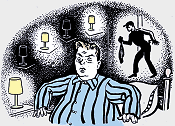 Jerry missed an opportunity to patent his
capacitive touch switch, the sort used to control everything from living room lamps
to kitchen sink faucets. Untold millions of dollars in royalties could have paid
for his engineering degree at Parvoo University and then the rest used as seed money
for a startup business. When I started reading this particular adventure of
Carl & Jerry in the March 1962 issue of Popular Electronics magazine,
I thought they were going to rig the metal door to issue a high voltage pulse to
whatever touched it. However, that probably would have been too much of a liability
for the publisher to risk since readers would sometimes replicate the devices described
in the articles. An element of stupid has always existed... Jerry missed an opportunity to patent his
capacitive touch switch, the sort used to control everything from living room lamps
to kitchen sink faucets. Untold millions of dollars in royalties could have paid
for his engineering degree at Parvoo University and then the rest used as seed money
for a startup business. When I started reading this particular adventure of
Carl & Jerry in the March 1962 issue of Popular Electronics magazine,
I thought they were going to rig the metal door to issue a high voltage pulse to
whatever touched it. However, that probably would have been too much of a liability
for the publisher to risk since readers would sometimes replicate the devices described
in the articles. An element of stupid has always existed...
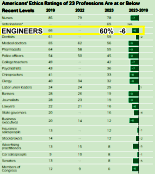 Ruh-roh, engineers took a hit in the latest
survey of 23 professions, as measured in Gallup's 2023
Honesty and Ethics poll. Nurses fared the best at 78% (down 7 points from pre-Covid
2019). Engineers rank 3rd at a mere 60% (-6 pts.), behind dog doctors at 65%.
People doctors come in at 56%, behind dentists. The medical community lost a lot
of support due to the Covid scam once reports surfaced about financial, social,
and vaccine abuses. Bankers and journalists hit 19%. As usual, politicians are at
rock bottom in the 6-8% realm. Not surprisingly, rankings given to professionals
by other professionals (those with college degrees) were higher than those assigned
by people without degrees. Conspicuously absent is a ranking for pollsters
like Gallup. I could not find a similar poll ranking skilled trade workers like
electricians, plumbers, and carpenters, only polls showing
Gen−Zers as a group don't want to get their hands dirty with such occupations. Ruh-roh, engineers took a hit in the latest
survey of 23 professions, as measured in Gallup's 2023
Honesty and Ethics poll. Nurses fared the best at 78% (down 7 points from pre-Covid
2019). Engineers rank 3rd at a mere 60% (-6 pts.), behind dog doctors at 65%.
People doctors come in at 56%, behind dentists. The medical community lost a lot
of support due to the Covid scam once reports surfaced about financial, social,
and vaccine abuses. Bankers and journalists hit 19%. As usual, politicians are at
rock bottom in the 6-8% realm. Not surprisingly, rankings given to professionals
by other professionals (those with college degrees) were higher than those assigned
by people without degrees. Conspicuously absent is a ranking for pollsters
like Gallup. I could not find a similar poll ranking skilled trade workers like
electricians, plumbers, and carpenters, only polls showing
Gen−Zers as a group don't want to get their hands dirty with such occupations.
 Rumor (according to me) has it that
Carl Kohler and his better half, Sylvia, were a real-life couple who lived in
the Syracuse, New York, area, and that his stories came from actual experiences.
This one is very believable, even if the details were changed a bit to make it more
interesting. Comical side note: Whenever I see or hear the first word in the
title, it reminds me of a time in Annapolis Junior High School (early 1970s) when
the teacher in a history class was running a film (pre-digital media days) and the
announcer used the word (which has an alternate meaning) in a sentence when describing
a mistake someone had made. A girl in the class burst out laughing so hard and uncontrollably
that she actually peed herself. That, of course, caused riotous laughter from the
entire class, which drew a lot of attention from neighboring classrooms. It's amazing
how such experiences stick with you for a lifetime... Rumor (according to me) has it that
Carl Kohler and his better half, Sylvia, were a real-life couple who lived in
the Syracuse, New York, area, and that his stories came from actual experiences.
This one is very believable, even if the details were changed a bit to make it more
interesting. Comical side note: Whenever I see or hear the first word in the
title, it reminds me of a time in Annapolis Junior High School (early 1970s) when
the teacher in a history class was running a film (pre-digital media days) and the
announcer used the word (which has an alternate meaning) in a sentence when describing
a mistake someone had made. A girl in the class burst out laughing so hard and uncontrollably
that she actually peed herself. That, of course, caused riotous laughter from the
entire class, which drew a lot of attention from neighboring classrooms. It's amazing
how such experiences stick with you for a lifetime...
 It was a lot of work, but I finally finished
a version of the "RF &
Electronics Schematic & Block Diagram Symbols"" that works well with Microsoft
Office™ programs Word™, Excel™, and Power Point™. This is an equivalent of the extensive
set of amplifier, mixer, filter, switch, connector, waveguide, digital, analog,
antenna, and other commonly used symbols for system block diagrams and schematics
created for Visio™. Each of the 1,000 or so symbols was exported individually from
Visio in the EMF file format, then imported into Word on a Drawing Canvas. The EMF
format allows an image to be scaled up or down without becoming pixelated, so all
the shapes can be resized in a document and still look good. The imported symbols
can also be UnGrouped into their original constituent parts for editing. Check them
out! It was a lot of work, but I finally finished
a version of the "RF &
Electronics Schematic & Block Diagram Symbols"" that works well with Microsoft
Office™ programs Word™, Excel™, and Power Point™. This is an equivalent of the extensive
set of amplifier, mixer, filter, switch, connector, waveguide, digital, analog,
antenna, and other commonly used symbols for system block diagrams and schematics
created for Visio™. Each of the 1,000 or so symbols was exported individually from
Visio in the EMF file format, then imported into Word on a Drawing Canvas. The EMF
format allows an image to be scaled up or down without becoming pixelated, so all
the shapes can be resized in a document and still look good. The imported symbols
can also be UnGrouped into their original constituent parts for editing. Check them
out!
 Amplifier Solutions Corporation (ASC) is
a manufacturer of amplifiers for commercial & military markets. ASC designs
and manufactures hybrid, surface mount flange, open carrier and connectorized amplifiers
for low, medium and high power applications using Gallium Nitride (GaN), Gallium
Arsenide (GaAs) and Silicon (Si) transistor technologies. ASC's thick film designs
operate in the frequency range of 300 kHz to 6 GHz. ASC offers thin film
designs that operate up to 20 GHz. ASC is located in an 8,000 sq.ft. facility
in the town of Telford, PA. We offer excellent customer support and take pride in
the ability to quickly react to evolving system design requirements. Amplifier Solutions Corporation (ASC) is
a manufacturer of amplifiers for commercial & military markets. ASC designs
and manufactures hybrid, surface mount flange, open carrier and connectorized amplifiers
for low, medium and high power applications using Gallium Nitride (GaN), Gallium
Arsenide (GaAs) and Silicon (Si) transistor technologies. ASC's thick film designs
operate in the frequency range of 300 kHz to 6 GHz. ASC offers thin film
designs that operate up to 20 GHz. ASC is located in an 8,000 sq.ft. facility
in the town of Telford, PA. We offer excellent customer support and take pride in
the ability to quickly react to evolving system design requirements.
Tuesday the 23rd
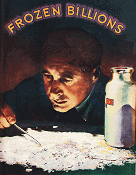 What does the 1942 Popular Mechanics
magazine article entitled "Frozen Billions" have to do with radium, you might reasonably
ask? The answer is that the most prolific
radium ore mine is located on a rocky point extending into Great Bear Lake in
the Northwest Territories in Canada. At the time of the mine's discovery, radium
was selling for $1,960,000 an ounce. This story about Marie and Pierre Curie's (oddly,
not mentioned in the article) 1898 discovery tells the history of the mine as well
as the many applications for radium's gamma ray emissions in industry, medicine,
and the military. Its properties made it worth billions of dollars in sales, but
its value in helping to beat back the Axis Powers in World War II was priceless.
The extreme high penetration of gamma rays (stronger than x−rays) made it useful
for inspecting massive solid mechanical devices like engine blocks, electric generator
housings, ship and airplane motor and transmission housings, and similar cast metal
shapes where internal voids can form. In small doses it treats cancer, makes aircraft
instrument and wristwatch dials readable at night, a generates low levels of heat.
With a half life of 1,690 years, a little radium goes a long way. What does the 1942 Popular Mechanics
magazine article entitled "Frozen Billions" have to do with radium, you might reasonably
ask? The answer is that the most prolific
radium ore mine is located on a rocky point extending into Great Bear Lake in
the Northwest Territories in Canada. At the time of the mine's discovery, radium
was selling for $1,960,000 an ounce. This story about Marie and Pierre Curie's (oddly,
not mentioned in the article) 1898 discovery tells the history of the mine as well
as the many applications for radium's gamma ray emissions in industry, medicine,
and the military. Its properties made it worth billions of dollars in sales, but
its value in helping to beat back the Axis Powers in World War II was priceless.
The extreme high penetration of gamma rays (stronger than x−rays) made it useful
for inspecting massive solid mechanical devices like engine blocks, electric generator
housings, ship and airplane motor and transmission housings, and similar cast metal
shapes where internal voids can form. In small doses it treats cancer, makes aircraft
instrument and wristwatch dials readable at night, a generates low levels of heat.
With a half life of 1,690 years, a little radium goes a long way.
 Ah, the idyllic EV scenario of a duplex
home with neighbors
charging their EVs on a sunshiny day. Beautiful - birds are singing, butterflies
are flittering. Note, however, the cars are outside because of fire risk when doing
so inside. Oh, and the charging cord is laying on the ground causing both an electrical
and tripping hazard. Fast forward six months and imagine digging the cord out of
snow and ice accumulated overnight, and trying to disconnect the plug where it's
frozen to the side of the car. If you've lived in the frigid north, you know of
what I speak. "Population growth [including millions of illegal immigrants,
RFC], electronics consumption and climate change present complex challenges
for today's electric grid operators and policymakers. Fortunately, emerging trends
and technologies in energy infrastructure are driving progress toward a more decentralized
and connected future that involves renewable, supplementary sources. These decentralized
systems must also coexist with the centralized grid to meet overall energy demands.
To keep up, the semiconductor industry..." Ah, the idyllic EV scenario of a duplex
home with neighbors
charging their EVs on a sunshiny day. Beautiful - birds are singing, butterflies
are flittering. Note, however, the cars are outside because of fire risk when doing
so inside. Oh, and the charging cord is laying on the ground causing both an electrical
and tripping hazard. Fast forward six months and imagine digging the cord out of
snow and ice accumulated overnight, and trying to disconnect the plug where it's
frozen to the side of the car. If you've lived in the frigid north, you know of
what I speak. "Population growth [including millions of illegal immigrants,
RFC], electronics consumption and climate change present complex challenges
for today's electric grid operators and policymakers. Fortunately, emerging trends
and technologies in energy infrastructure are driving progress toward a more decentralized
and connected future that involves renewable, supplementary sources. These decentralized
systems must also coexist with the centralized grid to meet overall energy demands.
To keep up, the semiconductor industry..."
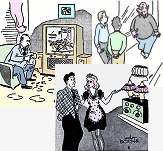 Maybe if you're having a challenging week,
these three
electronics-themed comics from vintage Radio & Television News
magazines (1949 and 1951) might ease the stress level a tad. The first one might
seem like a stretch, but in fact when I was in the USAF back in the early 1980s
I made two lamps using the big glass-encased thyratron tubes from our S-band airport
surveillance radar sets as the central column. One of them broke, and the other
I can't recall what happened to it; I might have given it to someone as a gift.
I'm not sure what the horse racing comic is meant to depict, other than maybe nowadays
you can watch your pick lose the horse race on the TV rather than needing to actually
be at the track. The ham comic is almost punny ;-) Enjoy... Maybe if you're having a challenging week,
these three
electronics-themed comics from vintage Radio & Television News
magazines (1949 and 1951) might ease the stress level a tad. The first one might
seem like a stretch, but in fact when I was in the USAF back in the early 1980s
I made two lamps using the big glass-encased thyratron tubes from our S-band airport
surveillance radar sets as the central column. One of them broke, and the other
I can't recall what happened to it; I might have given it to someone as a gift.
I'm not sure what the horse racing comic is meant to depict, other than maybe nowadays
you can watch your pick lose the horse race on the TV rather than needing to actually
be at the track. The ham comic is almost punny ;-) Enjoy...
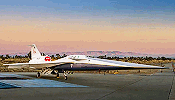 "NASA has
unveiled an experimental
quiet supersonic aircraft that it claims could pave the way for a new generation
of commercial aircraft that can travel faster than the speed of sound. Developed
in partnership with Lockheed Martin, the X-59 is the centerpiece of NASA's Quesst
mission, which focuses on providing data to help regulators reconsider rules that
prohibit commercial supersonic flight over land. For 50 years, the U.S. and other
nations have prohibited such flights because of the disturbance caused by loud,
startling sonic booms on the communities below. The X-59 is expected to fly at 1.4
times the speed of sound, or 925 mph while generating a quieter sonic thump. At
99.7 feet long and 29.5 feet wide, the aircraft's shape and the technological advancements
it houses will make quiet supersonic flight possible. The X-59's thin, tapered nose
accounts for almost a third of its length and will break up the shock waves that
would ordinarily result in a supersonic aircraft causing a sonic boom...." "NASA has
unveiled an experimental
quiet supersonic aircraft that it claims could pave the way for a new generation
of commercial aircraft that can travel faster than the speed of sound. Developed
in partnership with Lockheed Martin, the X-59 is the centerpiece of NASA's Quesst
mission, which focuses on providing data to help regulators reconsider rules that
prohibit commercial supersonic flight over land. For 50 years, the U.S. and other
nations have prohibited such flights because of the disturbance caused by loud,
startling sonic booms on the communities below. The X-59 is expected to fly at 1.4
times the speed of sound, or 925 mph while generating a quieter sonic thump. At
99.7 feet long and 29.5 feet wide, the aircraft's shape and the technological advancements
it houses will make quiet supersonic flight possible. The X-59's thin, tapered nose
accounts for almost a third of its length and will break up the shock waves that
would ordinarily result in a supersonic aircraft causing a sonic boom...."
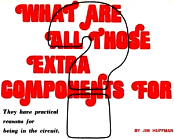 Maybe what piqued my interest in electronics
enough during my teenage years to eventually enter into the field as a lifelong
vocation was
wondering what the heck all those components were doing that were sprinkled around
circuit boards and inside product housings. The circuits I was building at the
time were typical beginning hobbyist types with just enough capacitors, resistors,
inductors, diodes, etc., to make the lamps blink properly or to pick up a strong
local AM radio station. Even in undergraduate college circuit design classes we
rarely went beyond noise bypass capacitors on ICs or counter-EMF-snubbing diodes
across solenoid coils. Having already been in the electronics world for many years
before college, I knew there was much more involved in producing reliable, trouble-free
circuits that worked well in a range of environments, and therefore was surprised
to find that those aspects of product design were left... Maybe what piqued my interest in electronics
enough during my teenage years to eventually enter into the field as a lifelong
vocation was
wondering what the heck all those components were doing that were sprinkled around
circuit boards and inside product housings. The circuits I was building at the
time were typical beginning hobbyist types with just enough capacitors, resistors,
inductors, diodes, etc., to make the lamps blink properly or to pick up a strong
local AM radio station. Even in undergraduate college circuit design classes we
rarely went beyond noise bypass capacitors on ICs or counter-EMF-snubbing diodes
across solenoid coils. Having already been in the electronics world for many years
before college, I knew there was much more involved in producing reliable, trouble-free
circuits that worked well in a range of environments, and therefore was surprised
to find that those aspects of product design were left...
 Banner Ads are rotated in all locations
on the page! RF Cafe typically receives 8,000-15,000 visits each
weekday. RF Cafe
is a favorite of engineers, technicians, hobbyists, and students all over the world.
With more than 17,000 pages in the Google search index, RF Cafe returns in
favorable positions on many types of key searches, both for text and images.
Your Banner Ads are displayed on average 280,000 times per year! New content
is added on a daily basis, which keeps the major search engines interested enough
to spider it multiple times each day. Items added on the homepage often can be found
in a Google search within a few hours of being posted. If you need your company news to be seen, RF Cafe is the
place to be... Banner Ads are rotated in all locations
on the page! RF Cafe typically receives 8,000-15,000 visits each
weekday. RF Cafe
is a favorite of engineers, technicians, hobbyists, and students all over the world.
With more than 17,000 pages in the Google search index, RF Cafe returns in
favorable positions on many types of key searches, both for text and images.
Your Banner Ads are displayed on average 280,000 times per year! New content
is added on a daily basis, which keeps the major search engines interested enough
to spider it multiple times each day. Items added on the homepage often can be found
in a Google search within a few hours of being posted. If you need your company news to be seen, RF Cafe is the
place to be...
 Please take a few moments to visit the
everythingRF website to see how they can assist you with your
project. everythingRF is a product discovery platform for RF and microwave products
and services. They currently have 267,269 products from more than 1397 companies
across 314 categories in their database and enable engineers to search for them
using their customized parametric search tool. Amplifiers, test equipment, power
couplers and dividers, coaxial connectors, waveguide, antennas, filters, mixers,
power supplies, and everything else. Please visit everythingRF today to see how
they can help you. Please take a few moments to visit the
everythingRF website to see how they can assist you with your
project. everythingRF is a product discovery platform for RF and microwave products
and services. They currently have 267,269 products from more than 1397 companies
across 314 categories in their database and enable engineers to search for them
using their customized parametric search tool. Amplifiers, test equipment, power
couplers and dividers, coaxial connectors, waveguide, antennas, filters, mixers,
power supplies, and everything else. Please visit everythingRF today to see how
they can help you.
These archive pages are provided in order to make it easier for you to find items
that you remember seeing on the RF Cafe homepage. Of course probably the easiest
way to find anything on the website is to use the "Search
RF Cafe" box at the top of every page.
About RF Cafe.
Homepage Archive Pages
2024:
Jan |
Feb |
Mar |
Apr |
May |
Jun |
Jul |
Aug |
Sep |
Oct |
Nov |
Dec
2023:
Jan |
Feb |
Mar |
Apr |
May |
Jun |
Jul |
Aug |
Sep |
Oct |
Nov |
Dec
2022:
Jan |
Feb |
Mar |
Apr |
May |
Jun |
Jul |
Aug |
Sep |
Oct |
Nov |
Dec
2021:
Jan |
Feb |
Mar |
Apr |
May |
Jun |
Jul |
Aug |
Sep |
Oct |
Nov |
Dec
2020:
Jan |
Feb |
Mar |
Apr |
May |
Jun |
Jul |
Aug |
Sep |
Oct |
Nov |
Dec
2019:
Jan |
Feb |
Mar |
Apr |
May |
Jun |
Jul |
Aug |
Sep |
Oct |
Nov |
Dec
2018:
Jan |
Feb |
Mar |
Apr |
May |
Jun |
Jul |
Aug |
Sep |
Oct |
Nov |
Dec
2017:
Jan | Feb |
Mar |
Apr |
May |
Jun |
Jul |
Aug |
Sep |
Oct |
Nov |
Dec
2016:
Jan |
Feb |
Mar |
Apr |
May |
Jun |
Jul |
Aug |
Sep |
Oct |
Nov |
Dec
2015:
Jan |
Feb |
Mar |
Apr |
May |
Jun |
Jul |
Aug |
Sep |
Oct |
Nov |
Dec
2014:
Jan |
Feb |
Mar |
Apr |
May |
Jun |
Jul |
Aug |
Sep |
Oct |
Nov |
Dec
2013:
Jan |
Feb |
Mar |
Apr |
May |
Jun |
Jul |
Aug |
Sep |
Oct |
Nov |
Dec
2012:
1 |
2 |
3 |
4 |
5 |
6 |
7 |
8 |
9 |
10 |
11 |
12 |
13 (no archives before 2012)
|








































